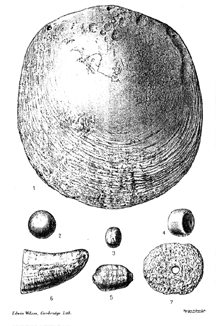
Tiaf Hapa, Toui, Tui
Tiaf Hapa was a breastplate made of pearl shell
In 1824, an explorer Lesson described that,
"the main ornament worn by those of a certain rank was a large pearl-oyster shell on the breast called a tifa. He noted that there were apparently, no oysters in Rotuma so these were traded with weavings. He also noted that some wore porcelain ovules called pouré also called pourao by the Tahitians"
Lesson also noted that,
“some wore a white braid on their breasts called toui, probably tui that was strung together, while others wore long strings of shells around their bodies”.
Lesson talked further about the beads which he noted were made of ivory, worn predominantly by women. He described that these beads were also made of whale tooth,
“Around the necks of some young people, I noticed necklaces made of balls of ivory. This ornament, usually worn by women”.
He was intrigued at the value our people equated to whales teeth noting that “the exchange of whales teeth was even preferred to fabric …. Rotumans considered the "whale to be the queen of the sea"…
He also noted "that the islanders found it astonishing that whales were caught by Europeans to use their oil for lamps”.
During my explorations of the British Museum I came across this bead and wondered whether this could have been a bead that Lesson described which was worn by the women.

Later in 1829, Dillon also talked about the importance of a type of white shell,
“where Rotumans regularly sailed to Vaitupu (Tuvalu) where these shells were abundant”
In 1898, Gardiner, noted that breastplate of pearl shell which were worn by the chiefs was called “tiaf hapa”. Gardiner made sketches of the pieces he found in his notes.

Macgregor also noted these breast plates on his explorations in 1932,
“they also wore breast plates which was made by shaping and taking off the rough shell.. he also noted that he found some of these pieces in their tombs”.